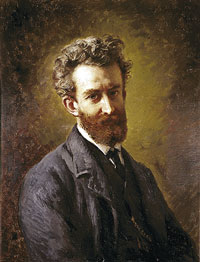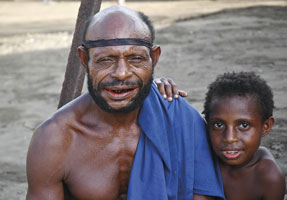 |
NIKOLAI MIKLOUHO-MACLAY: A RUSSIAN FRIEND OF THE PAPUANSPart I. Alone and Not Armed
"Not as a Russian, but rather as Tamo-boro-boro (the highest chieftain) of the Papuans from the Maclay Coast, do I wish to address His Royal Majesty with the request of patronage over my country and my people."
Nikolai Miklouho-Maclay
 The portrait of Miklouho-Maclay
by K. Makovsky
What Maps Remember No Longer
In the Bismarck Sea, which on modern Russian maps is indicated as the New Guinean Sea, there is Astrolabe Bay, named after the vessel of Jules Sébastien César Dumont d'Urville, a French explorer of the first half of the 19th century, who in 1827 during his around-the-world voyage schematically described the bay, although he had never gone ashore.
The first European who half a century later set foot on its shores was Russian ethnographer and explorer Nikolai Nikolayevich Miklouho-Maclay. Not only was he the first in history to establish contact with the inhabitants of this part of the planet's second biggest island – New Guinea – but he also lived among the local tribes (in this particular area of the island) for two and a half years.
Also, modern maps of New Guinea feature the Bismarck Archipelago, New Britain and New Ireland. But there is no mention of the once-acknowledged name of the Maclay Coast on them, despite the fact that in 1881 Miklouho-Maclay wrote: "The name of the Maclay Coast had been used by me as early as 1872 in order to procure a convenient point of reference for scientific research to avoid a constant repetition of the geographical location of the coast's explored part in between Cape of Croixille and Cape of King William – the coastal strip of land of over 150 miles long, which stretches inland up to the highest peaks and has an average width of 50 to 60 miles. That description had been acknowledged by scientific circles."
By what right? Here is what the explorer said: "… by the right of the first European who settled there, explored this shore and gained scientific results."
But after Germany annexed the northeast part of New Guinea in 1884, this part of the gigantic island shoreline became Kaiser Wilhelms land (even though he had hardly heard of it).
Also, maps no longer bear the following names: Pleased People Archipelago, Emerald or Vityaz (Russian Knight) Strait, Konstantin or Alexey Harbours, or even overland Meshchersky Peak (named after Prince Alexander Meshchersky, Maclay's friend from student times). International law is a good thing but, in reality, it protects only those who can protect themselves…
But the memories are still alive, even though the author's friends from the Indonesian part of New Guinea wonder: "Why do we know French and British explorers but do not know the Russian who had been here first?"
What People Remember
Nevertheless, the steel axe on the former Maclay Coast is still called Maclay Axe. Also, in 1977, when the research ship Dmitry Mendeleev with Russian ethnographers on board visited Astrolabe Bay, people from Bongu village performed the pantomime of Maclay's arrival, which was also depicted in the scientist's diary: "I regretted very much not being able yet to talk to them so I decided to go home and straighten my clothes up; this procedure really amused the Papuans around me. Then I got up, nodded my head at different directions and took the same path on my way back, which seemed shorter than in the morning."
 Tui Assel and a monument to Nikolai N. Miklouho-Maclay
It was the nodding at different directions that was left imprinted in the memories of the village dwellers… Now there is a new memory to add, as the first monument to a Russian citizen on Indonesian land, unveiled in Jakarta in March 2011, was of Miklouho-Maclay in commemoration of the 140th anniversary of his first voyage to the shores of New Guinea.
"He was an outstanding ethnographer and explorer. He is one of the pleiad of Russian explorers who studied societies outside of Europe," Meutia Hatta, adviser to the Indonesian president, former minister for women's empowerment and a daughter of one of the two founding fathers of independent Indonesia, said to the author at the unveiling ceremony.
 A woman frying corn, Gumbu village
In order to fully understand the essence of Maclay's scientific feat, one should know the correct answer not only to "who" and "why" but remember "how" it actually was. To do so, I will address the explorer's diaries again: "There is nothing new," said the entry made when Russian newspapers published the announcement of his sudden death. "Everything is the same old. In the morning, I am a zoologist-naturalist, then if people are sick, I am a cook, doctor, pharmacist, house painter and even laundress, and so on and so forth. In a word, a jack-of-all-trades and plenty of trades at that…"
A crew member of the Russian clipper Emerald that picked up Maclay after his first 15-month stay in New Guinea wrote under the pen name "N-y" (apparently, it was midshipman Nikolai Rimsky-Korsakov): "It was evident that those 15 months came at a dear cost; it was clear that he suffered through hunger and illness… After breakfast, I followed him on shore to see the way he lived and was surprised. One should have great courage to live in his hut for 15 months. There was a huge hole in the roof through which rain poured freely. That had happened recently due to the liana branch falling and breaking the roof. He felt unwell and thus wasn't fixing this."
Alone and Unarmed
The story of how Maclay achieved status when he walked among the Papuan unarmed and was able to stop inter-tribal wars by his authority alone is better told by the Russian ethnographer himself. Below, I cite his conversation with Signor Paldi, an Italian who was with him on the Sea Bird schooner and was left in Pubi village of the Admiralty Islands:
 An indigenous dweller of Bongu
"So, do you think, I will be killed by the locals?" asked Paldi suspiciously. – "Yes," I answered confidently. – "Why would they kill me? You haven't been killed on the Maclay Coast! Why would they kill me then? You got on with the aborigines in New Guinea! Are people different here?" Paldi began to ask in a somewhat offended way in which one could also recognise annoyance and distrust. – "The main reasons are the following: you are a hot-bloodied Southerner while I am from the North. You rely on your revolver to be your friend, helper and strength, while my strength on the Maclay Coast was my good and fair attitude towards the natives, and I never saw a revolver as a useful tool there. You want the locals to fear you because of your revolver and gun, while I sought and gained their trust and friendship. These are the most fundamental differences between our principles of treating locals. There are also secondary reasons that make your success difficult. For instance, one would be that you are staying inside the very village of the natives. Don't you think that soon you'll become an eyesore that they will try to get rid of? Staying in New Guinea, I settled down in the forest where nobody ever lived before me and for which nobody claimed any rights, and built my hut a mile away from one village and two miles away from another one… One more serious reason hindering your success is that all the natives who saw you moving your things from the schooner know which riches, in their opinion, will be kept in your hut. Do you think that none of them will have the idea that one successful shot of a thrown spear would make these riches theirs? You can say that it is improbable that the first thrown spear would reach its target, and your gun would put the offender down immediately and make the others scatter! I agree and even believe that being, as you claim, a good gunman, you can put down on the spot not just one but six people, with each bullet getting its man. So much the worse for you. Everybody will scatter but this will add to their desire to get your riches and urge them or even make it their duty (mandatory for the locals) to take revenge! Enough for now, but there is plenty more to be said. I have deliberately said more than I had intended to earlier because I think you still have time to change your mind."
Maclay was right. "Even though my words seemed to make Paldi ponder, he stayed in Pubi. His murder proved me right. As I mentioned earlier, I was not able to find out how long he lived there. In the eyes of the natives, his death was gloriously avenged by the White, as skipper X shot 50 or 60 people on the spot…"
But how did Maclay find himself on the shores of New Guinea?
A Scottish Cossack among the Papuans
At the age of 22, Nikolai Miklouho, born on 17 July 1846 in Yazikovo-Rozhdenstvenskoye village, in the Novgorod region, started to call himself Miklouho-Maclay. Nobody knows exactly why he took this double surname but, apparently, he believed the family legend tracing its ancestry back to a Scottish man Maclay, who joined the Zaporozhskaya Sech in the time of Peter the Great.
 The monument to Miklouho-Maclay in Jakarta
It was much later that he got support from and worked with famous contemporaries such as Leo Tolstoy, Russian Emperor Alexander III, his teacher, well-known German naturalist Ernst Haeckel (who, by the way, coined the term "ecology"), and many others. But as early as spring 1870, Thomas Huxley mentioned in one of his letters his encounter with a young Russian scientist: "… Miklucho-Maclay has been here; I have seen a good deal of him, and he strikes me as a man of very considerable capacity and energy."
One should indeed be of considerable energy to be able, at less than 30 years of age, to raise funds for a scientific expedition to the other end of the world where no European had set foot before.
Moreover, Maclay was by no means attracted by natural wonders or untouched resources. The young scientist wrote in the project justification: "Reading the travel stories, I found most of them lacking a sufficient description of the indigenous people in their primeval existence, that is, how people have lived and live before their close encounter with white people or other races with formed civilisations… Travellers either stayed with the locals for too short a period of time to learn their way of life, customs, intellectual abilities and so on, or they mainly engaged in collecting plants, watching other animals and paying minor attention to people. On the other hand, having met the European civilisation, those races disappear with every year."
Read the end of the story in the next issue.
Text Mikhail Tsyganov
Photos Alexander Pototsky
|
|
 +65 6696 7068
+65 6696 7068
 info@meridian103.com
info@meridian103.com
 PDA
PDA
 +65 6696 7068
+65 6696 7068
 info@meridian103.com
info@meridian103.com
 PDA
PDA

Y contact is Office of the Provincial Administrator
Chris NANTO Torot
PO Box 2139
Madang 511
Madang Rrovince
Papua New Guonea
Email christorot@gmail.com
Phone 67571782293
6754222016
Chris Torot, 2018-09-17